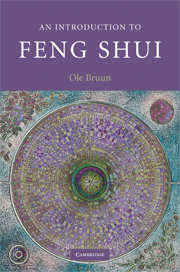Book contents
- Frontmatter
- Contents
- List of illustrations
- 1 Introduction
- 2 A brief history of feng shui
- 3 Feng shui in the context of Chinese popular religion
- 4 Feng shui research
- 5 Cosmological principles, schools of interpretation and the feng shui compass
- 6 Feng shui in the Chinese cityscape: China proper and overseas
- 7 Modern feng shui interpretations and uses
- 8 Environmental concerns
- 9 Feng shui as cultural globalization?
- Bibliography
- Index
9 - Feng shui as cultural globalization?
Published online by Cambridge University Press: 05 June 2012
- Frontmatter
- Contents
- List of illustrations
- 1 Introduction
- 2 A brief history of feng shui
- 3 Feng shui in the context of Chinese popular religion
- 4 Feng shui research
- 5 Cosmological principles, schools of interpretation and the feng shui compass
- 6 Feng shui in the Chinese cityscape: China proper and overseas
- 7 Modern feng shui interpretations and uses
- 8 Environmental concerns
- 9 Feng shui as cultural globalization?
- Bibliography
- Index
Summary
Just half a century ago, no one would have envisioned a place for feng shui in modern western societies. The tradition of feng shui, among those relatively few who knew of its existence, was perceived as a most peculiar aspect of Chinese culture, brought down through China's long history because of inherent conservatism and general stagnation. It was seen as superstitious and obsolete, bound for destruction in the quest for modernity. Western observers, whether of missionary, social science or political background, would at least share this faith in progress. Among the Chinese themselves, both revolutionaries and liberals would agree to this. Few saw any purpose of sorting out useful and less useful aspects of traditional cosmology.
At this time, ideologies were moving across continents at a rapid pace. The main currents of thought in the Chinese modernization process – Christianity, Marxism and liberalism – were all western constructs. It is of great importance, however, that such currents inevitably will be adapted to the local culture in the process of their transfer. Christianity was most often mixed with Chinese ancestor worship, and Marxism was adapted in the form of Maoism, a new radical form with a personality cult around Mao himself. Ideologies develop new hybrids when moved across cultures, often to the point of becoming unrecognizable.
- Type
- Chapter
- Information
- An Introduction to Feng Shui , pp. 191 - 195Publisher: Cambridge University PressPrint publication year: 2008



